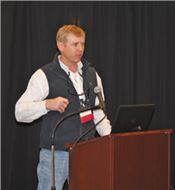|
AgCenter Research Featured At National Conservation Systems Cotton & Rice Conference

Farmer Wes Simon, of Acadia Parish, tells an audience at the National Conservation Systems Cotton and Rice Conference in
Baton Rouge about the practices used on the Simon family farm to grow rice, soybeans, crawfish and cattle.
Photos by Bruce Schultz/LSU AgCenter
BATON ROUGE, LA.
LSU AgCenter scientists and researchers were among the presenters at the National Conservation Systems Cotton and Rice Conference on Jan. 31 and Feb. 1.
AgCenter entomologist Sebe Brown said a new product to control soybean loopers infects the larvae with a virus that kills the pest and spreads naturally across soybean fields.
The product, Chrysogen, should be available in Louisiana by July, hopefully in time to treat fields where loopers are found, he said.
Redbanded stink bugs were controlled by last year’s cold winter, but so far the temperatures have not been low enough this winter to have the desired effect. Warm weather will allow early development of clover where redbanded stink bugs will be found until crops mature. Last year, Brown said, clover development was delayed until April, and that helped keep the insect numbers low.
AgCenter cotton and corn specialist Dan Fromme said the highest yields from cotton are not from the tallest or greenest plants. Soil type and the previous crop grown on a field play a major role in yield.
Higher rates of nitrogen for cotton are needed on clay soils, Fromme said.
Steve Linscombe, retired director of the AgCenter H. Rouse Caffey Rice Research Station and now executive director of the Rice Foundation, gave a report on the sustainability of U.S. rice farming.
From 1980 until 2015, he said, rice yields increased by 62 percent, but land use has decreased by 39 percent. Water use has declined by 52 percent, and farmers use 34 percent less energy. Greenhouse gases have decreased by 41 percent, and soil loss has been reduced by 28 percent.
“Rice produces a lot of habitat for wildlife,” Linscombe said. Conservation programs have provided farmers with $80 million in compensation for providing 700,000 acres of waterfowl habitat.
Don Groth, AgCenter plant pathologist and resident coordinator of the H. Rouse Caffey Rice Research Station, said his work has shown little advantage of a fungicide used as a seed treatment.
Seed treatments for the rice water weevil also help with disease control. Groth explained that controlling weevils often requires draining a field, and that sets the conditions for blast disease to develop.
Farmers should remember that fungicides offer preventative action to protect a plant against disease and are not curative, he said.
Smut diseases are becoming more prevalent in rice, he said, and fungicides for smut have to be applied at boot stage.
Farmer Wes Simon, of Acadia Parish, gave a presentation on practices used on the farm he operates with his brother and father.
Variable-rate fertilizer applications are used by comparing soil sample results with yield maps to determine where nutrients are needed. The Simons also want to obtain uniform pH levels throughout their fields, he said.
Rice farmers have improved water quality, with cleaner water leaving their fields. “Rice is a natural filter for water,” Simon said.
AgCenter rice breeder Adam Famoso said a new Provisia line, PVL02, shows better ratoon yields than the first version of Provisia. Five acres of the line will be harvested soon for seed production, and a commercial release is possible in 2020.
The hybrid LAH169 developed by AgCenter rice breeder Jim Oard could provide an alternative to commercially available hybrids with good yield and quality.
Famoso also said two long-grain lines under development for the past two years are being grown in Puerto Rico for a seed increase. Both lines will be tested further this year, and a decision will be made on whether they will be released as varieties.
AgCenter rice specialist Dustin Harrell said the row rice crop in north Louisiana doubled to 10,000 acres last year, and it’s likely to increase this year. Arkansas had 100,000 acres of row rice, and that’s likely to jump by 50,000 acres.
Harrell said growing row rice in south Louisiana would be complicated because of permanent levees and crawfish farming. Whether row rice could be used for a second crop will be researched further, he said.
AgCenter weed scientist Eric Webster said the fine mists used by aerial applicators have the potential to drift. Small drops of liquid have a better chance of drifting in the atmosphere before reaching a target.
“It costs you money to go fast. Slow down. Increase your volume, and you’re going to get your money back,” he said.
Texas A&M entomologist Mo Way said an emergency application to the U.S. Environmental Protection Agency has been made to use a bird repellent, using a chemical similar to the AV-1011 seed treatment, on mature rice. That product was tested on mature rice at the AgCenter Rice Research Station with good results. ∆

LSU AgCenter extension rice specialist Dustin Harrell tells an audience at the National Conservation Systems
Cotton and Rice Conference in Baton Rouge about using products to minimize fertilizer losses in rice.
|
|